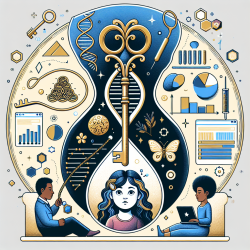As practitioners dedicated to improving child outcomes, it's crucial to stay informed about the latest scientific advancements. The recent study titled "Meta-analysis of genome-wide association studies identifies 8 novel loci involved in shape variation of human head hair" offers valuable insights that can be leveraged to enhance our therapy practices. By understanding the genetic factors influencing hair shape, we can refine our approaches and encourage further research in this area.
This groundbreaking study analyzed data from 28,964 subjects across multiple geographic origins, identifying 8 novel loci associated with hair shape variation. These findings not only expand our knowledge of genetic determinants but also provide a foundation for future functional studies. As a practitioner, integrating these insights into your therapy sessions can lead to more personalized and effective interventions.
Key Findings and Their Implications
The study identified eight novel loci and confirmed four previously known ones, all showing significant associations with hair shape. The novel loci include:
- 1p36.23 ERRFI1/SLC45A1
- 1p36.22 PEX14
- 1p36.13 PADI3
- 2p13.3 TGFA
- 11p14.1 LGR4
- 12q13.13 HOXC13
- 17q21.2 KRTAP
- 20q13.33 PTK6
Understanding these genetic markers allows us to appreciate the biological underpinnings of hair shape, which can be a significant aspect of a child's identity and self-esteem. By incorporating this knowledge, we can create more holistic and personalized therapy plans that consider genetic factors.
Implementing Research Findings in Therapy
Here are some ways you can implement these findings to improve your practice:
- Personalized Therapy: Use genetic information to tailor therapy plans, addressing specific needs related to hair shape and self-perception.
- Parent Education: Educate parents about the genetic aspects of hair shape, helping them understand and support their child's unique characteristics.
- Collaborative Research: Encourage collaboration with genetic researchers to explore further the implications of these findings in child development and therapy.
- Training and Workshops: Organize training sessions and workshops for fellow practitioners to disseminate these insights and promote data-driven practices.
Encouraging Further Research
While this study has significantly advanced our understanding, there is still much to explore. Encourage further research by:
- Participating in Studies: Get involved in ongoing genetic research projects and contribute your expertise.
- Funding Initiatives: Advocate for funding and resources to support comprehensive studies on genetic factors affecting child development.
- Interdisciplinary Collaboration: Foster partnerships with geneticists, psychologists, and other specialists to conduct multifaceted research.
By integrating these findings into your practice and promoting further research, you can contribute to a more comprehensive understanding of child development and therapy.
To read the original research paper, please follow this link: Meta-analysis of genome-wide association studies identifies 8 novel loci involved in shape variation of human head hair.










